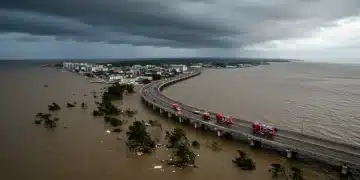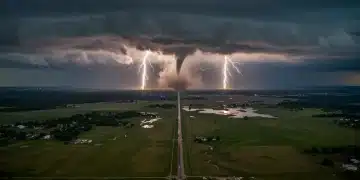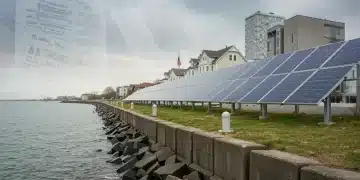Building Resilient Infrastructure: 7 Steps for US Cities
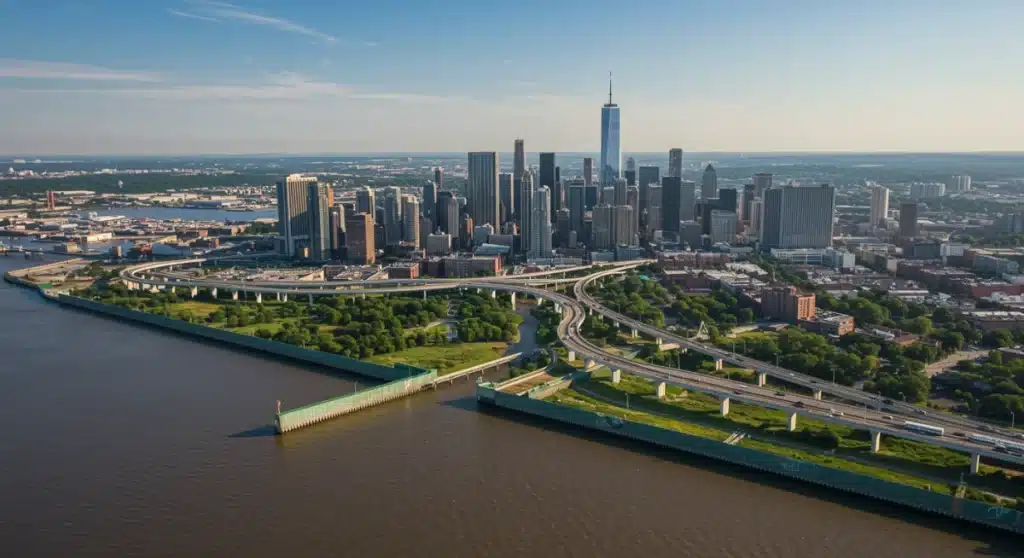
U.S. cities must urgently implement strategies for building resilient infrastructure to effectively adapt to escalating climate shocks, safeguarding urban populations and economic stability against future environmental challenges.
As climate change intensifies, U.S. cities face unprecedented challenges. The imperative for building resilient infrastructure has never been more critical, demanding immediate and strategic action to protect urban populations and economies from future climate shocks.
Understanding the Urgent Need for Resilience
The frequency and intensity of extreme weather events, from devastating floods to prolonged heatwaves, are rapidly increasing across the United States. This escalating threat underscores the critical need for urban centers to move beyond traditional infrastructure development and embrace a proactive approach to resilience.
Traditional infrastructure, often designed for past climatic conditions, is proving inadequate against current and projected climate impacts. Cities must now prioritize investments that not only repair and maintain existing systems but also fundamentally transform them to withstand future shocks. This paradigm shift involves integrating climate science into every stage of planning and development, ensuring that new projects are future-proofed and existing ones are adapted.
The Economic and Social Imperatives
Beyond the immediate physical damage, climate shocks inflict significant economic and social costs. Businesses face disruptions, supply chains are broken, and public health systems are strained. Vulnerable communities often bear the brunt of these impacts, exacerbating existing inequalities.
- Economic losses from extreme weather events are projected to rise significantly.
- Displacement of populations due to climate-related disasters is becoming more common.
- Increased strain on emergency services and public health infrastructure.
Addressing these challenges through resilient infrastructure development is not merely an environmental concern; it is an economic necessity and a moral obligation to protect all citizens.
Step 1: Comprehensive Climate Risk Assessment
The foundation of any effective resilience strategy is a thorough understanding of current and future climate risks. U.S. cities must conduct detailed assessments to identify specific vulnerabilities and prioritize interventions based on localized climate projections.
These assessments should go beyond historical data, incorporating advanced climate modeling to predict future scenarios. This includes analyzing potential impacts from sea-level rise, increased precipitation, extreme temperatures, and more frequent severe storms. Understanding these risks at a granular level allows cities to tailor solutions that are most effective for their unique geographical and socio-economic contexts.
Utilizing Advanced Data and Mapping
Modern technology offers powerful tools for risk assessment. Geographic Information Systems (GIS) can map out vulnerable areas, identifying critical infrastructure assets at risk. Data analytics can help forecast the likelihood and severity of various climate events, informing strategic planning.
- High-resolution climate models for localized predictions.
- Vulnerability mapping of critical infrastructure (e.g., power grids, water treatment plants).
- Socio-economic data integration to identify at-risk populations.
This data-driven approach ensures that investments in building resilient infrastructure are targeted, efficient, and maximize protective benefits for the community.
Step 2: Integrating Green Infrastructure Solutions
Green infrastructure, which mimics natural hydrological processes, offers cost-effective and environmentally friendly solutions for urban resilience. U.S. cities are increasingly adopting these approaches to manage stormwater, mitigate heat, and enhance biodiversity.
From permeable pavements and rain gardens to urban forests and constructed wetlands, green infrastructure can significantly reduce flood risks, improve water quality, and combat the urban heat island effect. These solutions often provide multiple co-benefits, such as creating public green spaces, improving air quality, and supporting local ecosystems, making cities more livable and sustainable.
Examples of Successful Green Infrastructure Projects
Many cities have already begun to implement innovative green infrastructure projects. Philadelphia’s Green City, Clean Waters program, for instance, uses green stormwater infrastructure to manage runoff and improve water quality, demonstrating a scalable model for other urban areas.
- Rain gardens and bioswales to absorb and filter stormwater.
- Green roofs and walls to reduce building energy consumption and manage runoff.
- Urban tree canopy expansion to provide shade and improve air quality.
These natural systems are a vital component of building resilient infrastructure, offering flexible and adaptive solutions to climate challenges.
Step 3: Modernizing and Hardening Existing Systems
While new infrastructure is crucial, U.S. cities must also focus on upgrading and hardening their existing systems to withstand future climate impacts. This involves reinforcing bridges, elevating essential utilities, and protecting critical facilities from flooding and other hazards.
Modernization efforts can include installing smart grid technologies to enhance energy reliability during extreme weather, or upgrading water treatment facilities to cope with increased turbidity from heavy rainfall. The goal is to ensure that essential services remain operational even under adverse conditions, minimizing disruption and accelerating recovery.
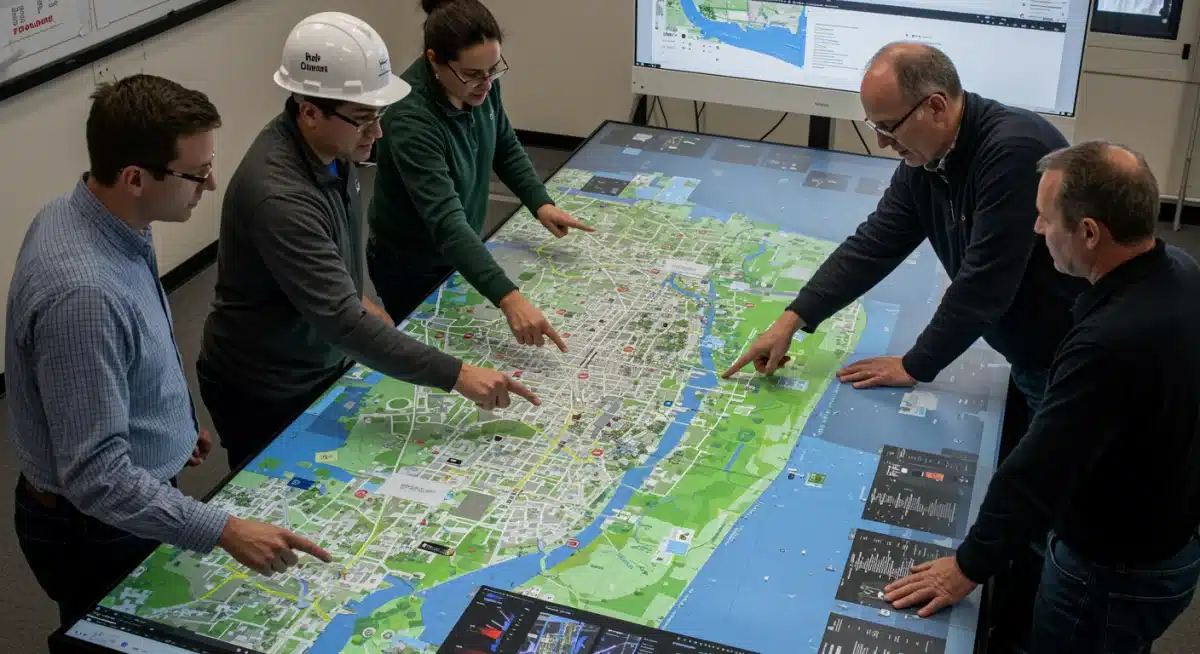
Protecting Critical Utilities
Utilities such as power, water, and communication networks are particularly vulnerable to climate shocks. Hardening these systems involves strategic investments to make them more robust and less susceptible to outages.
- Undergrounding power lines in high-risk areas.
- Elevating substations and water pumps above projected flood levels.
- Implementing redundant systems to ensure continuous service during failures.
These measures are fundamental to building resilient infrastructure and maintaining public welfare during emergencies.
Step 4: Developing Robust Early Warning Systems
Effective early warning systems are vital for minimizing the impact of impending climate shocks. U.S. cities need to invest in advanced monitoring technologies and communication networks to provide timely alerts to residents and emergency responders.
These systems can track severe weather patterns, predict flood levels, and monitor air quality during heatwaves or wildfires. The ability to disseminate critical information quickly allows for proactive measures, such as evacuations, sandbagging efforts, and the activation of emergency shelters, saving lives and reducing property damage.
Enhancing Communication and Public Awareness
Beyond technology, the effectiveness of early warning systems depends on clear, consistent communication with the public. Cities must develop robust communication strategies to ensure that all residents, especially vulnerable populations, receive and understand emergency alerts.
- SMS alerts, public address systems, and social media for rapid dissemination.
- Community education programs on preparedness and response.
- Multi-language alerts to reach diverse populations effectively.
A well-informed public is a resilient public, ready to respond to climate threats as part of the broader effort in building resilient infrastructure.
Step 5: Fostering Cross-Sector Collaboration and Governance
Building resilient infrastructure is not solely the responsibility of municipal governments. It requires a collaborative effort involving state and federal agencies, private sector entities, academic institutions, and local communities. U.S. cities must establish strong governance frameworks to facilitate this cross-sector collaboration.
Effective resilience planning involves breaking down silos between departments and agencies, ensuring a coordinated approach to climate adaptation. Public-private partnerships can leverage diverse expertise and resources, accelerating the implementation of resilience projects. Community engagement is also crucial, as local knowledge and input can inform more effective and equitable solutions.
Establishing Resilience Hubs and Task Forces
Many cities are creating dedicated offices or task forces focused on climate resilience, bringing together stakeholders from various sectors. These hubs can serve as central points for planning, coordination, and resource allocation.
- Inter-agency task forces for integrated planning.
- Public-private partnerships for funding and expertise.
- Community advisory boards to ensure equitable solutions.
This collaborative ecosystem ensures that resilience strategies are comprehensive, well-funded, and reflect the diverse needs of the urban environment.
Step 6: Securing Sustainable Funding and Financing
Implementing large-scale resilient infrastructure projects requires significant financial investment. U.S. cities must explore diverse funding mechanisms, including federal grants, state programs, private financing, and innovative public-private partnerships, to ensure long-term sustainability.
Beyond traditional funding sources, cities can explore green bonds, revolving loan funds, and impact investing to finance resilience initiatives. Advocating for increased federal investment in climate adaptation and demonstrating the long-term economic benefits of resilience can also help secure necessary resources.
Innovative Financing Mechanisms
Creative financial models are emerging to address the funding gap for resilient infrastructure. These include mechanisms that attract private capital by demonstrating clear returns on investment through reduced disaster costs and enhanced economic stability.
- Green bonds for environmentally beneficial projects.
- Resilience bonds linked to specific climate risk reduction outcomes.
- Leveraging federal infrastructure bills and grants.
A robust financial strategy is paramount for successfully building resilient infrastructure and ensuring its continuous development.
Step 7: Continuous Monitoring, Evaluation, and Adaptation
Resilience planning is not a one-time effort but an ongoing process. U.S. cities must establish mechanisms for continuous monitoring and evaluation of their resilience strategies, adapting them as climate conditions evolve and new data emerges.
Regular assessments of infrastructure performance during and after climate events provide valuable lessons learned, informing future adjustments. This iterative process ensures that resilience plans remain relevant, effective, and responsive to changing environmental realities. Flexibility and adaptability are key to long-term success in the face of an uncertain climate future.
Learning from Experience and Global Best Practices
Cities should actively share knowledge and best practices, both domestically and internationally. Learning from the successes and failures of other urban areas can accelerate the development of effective resilience strategies.
- Post-event assessments to identify strengths and weaknesses.
- Regular review and updates of climate risk assessments.
- Participation in global resilience networks and forums.
This commitment to continuous improvement is essential for sustaining the momentum in building resilient infrastructure and securing a safer future for urban populations.
| Key Step | Brief Description |
|---|---|
| Climate Risk Assessment | Identify specific vulnerabilities and potential impacts from future climate shocks using advanced modeling. |
| Green Infrastructure | Implement natural solutions like rain gardens and urban forests to manage stormwater and mitigate heat. |
| Modernize Systems | Upgrade and harden existing utilities and facilities to withstand extreme weather events. |
| Early Warning Systems | Invest in advanced monitoring and communication to provide timely alerts and enable proactive responses. |
Frequently Asked Questions About Resilient Infrastructure
Resilient infrastructure is crucial due to the increasing frequency and intensity of climate shocks like floods, heatwaves, and storms. It protects urban populations, minimizes economic losses, and ensures vital services remain operational, safeguarding communities against future environmental impacts.
Green infrastructure, including rain gardens and urban forests, uses natural processes to manage stormwater, reduce urban heat, and enhance biodiversity. These solutions offer cost-effective and sustainable ways to adapt cities to climate change, providing multiple environmental and social benefits.
Cities can secure funding through diverse mechanisms, including federal grants, state programs, private sector investments, and innovative financing tools like green bonds. Public-private partnerships and advocacy for increased federal climate adaptation budgets are also key to securing necessary resources for large-scale projects.
Comprehensive climate risk assessments identify specific vulnerabilities and prioritize interventions based on localized climate projections. They help cities tailor solutions, optimize resource allocation, and ensure that investments in infrastructure are targeted, efficient, and maximize protective benefits for the community.
Continuous monitoring ensures that resilience plans remain effective and responsive to evolving climate conditions. Regular assessments, informed by real-world events, allow cities to adapt their strategies, incorporate lessons learned, and maintain flexibility in the face of an uncertain and changing climate future.
Looking Ahead: The Path to Climate-Ready Cities
The journey towards building resilient infrastructure in U.S. cities is a continuous process, demanding proactive engagement and adaptive strategies. As climate patterns continue to shift, the emphasis will remain on innovation, collaboration, and sustained investment. Federal support, alongside local initiative, will be critical in scaling these efforts. Cities that embrace these steps will not only protect their residents and economies but also emerge as leaders in global climate adaptation, setting a new standard for urban development in the 21st century. The actions taken today will define the safety and prosperity of urban centers for generations to come, highlighting the urgency of immediate and decisive action.
